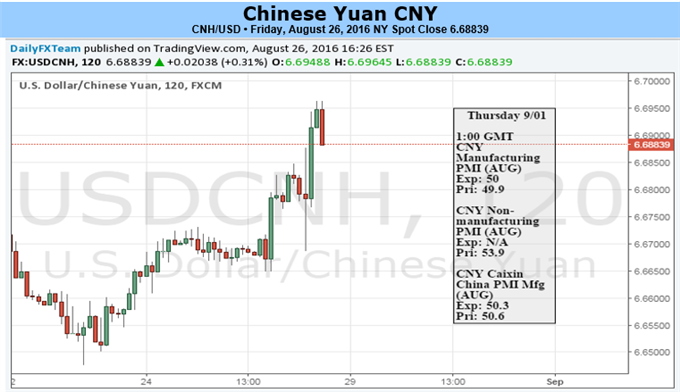Yuan Range to Extend on Mixed PBOC, Fed Policy
DailyFX.com -

Fundamental Forecast for the Yuan: Neutral
China’s Market News: Bond Prices Remain Elevated Despite PBOC Actions
What Are the Traits of Successful Traders? Get FXCM’s Free New eGuide
Fed Chair Yellen’s comments on monetary policy on Friday led to the widest trading range of the week for the Dollar/Yuan after relatively quiet price action for the four days prior. Immediately following the release, the offshore Yuan dove to new weekly lows against the US Dollar; five minutes after the release, the offshore Yuan quickly reversed the loss and rose to new session highs, while two hours later the offshore Yuan dropped again with USD/CNH touching 6.6944, the weakest level for the Yuan since July 20th. This week, the USD/CNH rate has hold above the level of 6.6500 as support while the USD/CNY rate found support around 6.6375. Yellen’s comments add considerable volatility to FX markets but still did not give out a clear outlook around immediate Fed rate hikes. Without such a clear outlook, Dollar/Yuan rates are less likely to rose above the major resistance level of 6.7000 amid the PBOC’s guidance. Also, G-20 meetings to be held from August 31st to September 5th will continue be a primary theme for the Chinese currency. Event risk from China and its major counterpart of the U.S.A, including China’s August PMI and US Non-Farm Payroll prints, could elevate volatility in Yuan rates as well.
The Fed’s discussions on rate hikes will continue to weigh on Dollar/Yuan rates. In her speech in Jackson Hole, Chair Yellen confirmed a monetary policy that is ‘not preset’ and will be adjusted to ‘a wide range of possible conditions’, as the economic outlook is uncertain. She both addressed that ‘the case for rate hike has strengthened’ amid improved economic data but also left door open for easing measures if conditions become worse. Yuan moves following reflect this uncertainty: the first 1-hour candle of USD/CNH following the release of Yellen’s remarks shows extreme long upper and lower wicks but a small body, indicating traders’ divided opinions on the outlook of U.S. economy as well as Fed rate hikes. Major indicators to be released next week could give traders more clues on the prospects of the U.S economy. In addition to the key market driver of Non-Farm Payrolls, the U.S. will issue the August prints for Personal Income, Home Sales and Consumer Confidence. These gauges could help traders to get a more accurate picture of the broader economy and may better forecast the Fed’s moves.
On China’s side, the monetary policy is more straight-forward: the introduction of 14-day reverse repos this week further reduces the odds of the PBOC cutting rates. Curbing price bubbles in financial markets is still their main priority, although the efficiency of China’s monetary policy seems to be diminishing. On August 26th, the PBOC’s Chief Economist Ma Jun addressed the transmission mechanism of monetary policy has encountered some issues: The efficiency of the PBOC’s influence in medium-to long-term bond rates through guidance in short-term bond rates is only 70% of the efficiency in other major central banks; the efficiency of the PBOC’s influence in loan interest rates through guidance in short-term interest rates is merely 50% of the efficiency in other major central banks. This explains why the yield of Chinese 10-year government bond remains low, despite the fact that the PBOC has been increasing short-term borrowing costs. Within such context, the PBOC needs to improve the policy efficiency first before making any major moves. The current moderate policy could help the Yuan avoid sudden plunges driven by internal forces. Also, the G20 meetings, a top event for China, will start next week on next Wednesday. As we discussed last week, Yuan rates saw low volatility ahead of past G20 meetings; it could be the case this time as well. Next week, the offshore Yuan may continue to consolidate with a range between 6.6500 and 6.7000 with this main theme.
DailyFX provides forex news and technical analysis on the trends that influence the global currency markets.
Learn forex trading with a free practice account and trading charts from FXCM.

 Yahoo Finance
Yahoo Finance 
